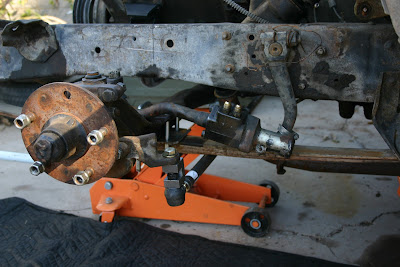There are a couple different ways to take the "Green Acres" right out of your 57-60 F100, if you so desire.

First off:
1) Remove the spare tire from inside the bed.

then....

...Do what the man says:
2) Decrease overall ride height 6-8 inches:

OK- the first can be done with your wife's tool kit in a few seconds, the latter- well, it can be more like a second job. Of course it depends upon your knowledge and skill level. Let's just say that it's been a learning experience so far.
There are several different ways to approach this- I'll cover each one, including Pro's and Con's of everything I've learned so far:
IFSFirst things first- this ain't happening. For a couple different reasons:
1) This truck isn't being built for road racing, or for "layin' rocker"
2) It's nowhere near as cheap or easy as everyone thinks, to pull off CORRECTLY.
3) If I wanted a '96 F-150, or a Volare, or a '70-'81 Camaro, I'd go buy one.
With that out of the way, here's some choices for lowering it "old skool".
Dropped mono LeafsFirst, and by far the easiest.
You can get these from Sacramento Vintage Ford pretty reasonably. I think for abut $400 per axle.
Pro:
1) Quick and relatively easy.
2) You can choose a from couple differently sized drops.
Con:
1) Makes for a "bouncy" ride.
2) Forget about actually using your truck as a truck- hauling potential is about a "2" on a 1-10 scale.
3) Possible bump Steer/Steering geometry issues.
Here's a photo of a mono leaf setup. Looks like about 2" of suspesnion travel before bottoming out. This is with no front end sheetmetal or driver (another 400-500 lbs):
 Dropped Tube Axle
Dropped Tube AxleCommonly available drop axles are actually created for the '53-'56 F100, and then modified slightly for the '57-'60 (the 57-60 has a 1/4" wider leaf spring).
Here's a caveat of sorts- the the stock 57-60 axle geometry has a 1.0" drop over the 53-56 axle. So....all of the 3.0" dropped axles available will only drop your Fridge by 2.0".

Pro:
1) The "Right" way
1) Gives a "true" geometrical drop (not just a compromise in suspension travel)- steering geometry issues resolved by using a relatively inexpensive "Tie Rod Drop Kit".
2) You get a new axle.
Con:
1) Pretty pricey. Kingpins, U-Bolts, Tie Rod Drop Kit, and Axle will run you almost 6 bills for a 2.0" drop.
2) Installation not easy.
Classic trucks magazine did a feature on this kind of drop:
http://www.classictrucks.com/tech/0610cl_ford_suspension/index.htmlhttp://www.classictrucks.com/tech/0611cl_1960_ford_f100/index.htmlDropped I-Beam AxleYou can have the factory I-Beam axle "Dropped" by a drop axle service. There are a couple of them around in California and Arizona. Price is comparable to new dropped tube axle.
(I hear that you can safely drop a stock axle to 4.0". HINT: I'm guessing that this is common wisdom for a 2600lb open car, and not 3600lb truck.)
Pro:
1) I'd call this a reasonable price to pay for lowering.
2) Again- a "true" drop, but you're on your own in resolving bump steer issues.
Cons:
1) No guarantee that you will ever get your front end aligned properly, or have a tight hole for kingpins.
2) Same gig as tube axle as far as Installation.
Here is a another great link from the HAMB:
http://www.jalopyjournal.com/forum/showthread.php?t=92817"Trick" the stock leaf springsYou can do this three ways- by removing one or more of the seven leafs in each leaf spring, by having the spring eyes "reversed", or by having the springs de-arched.
OR, a combination of all three:
There are two basic approaches to removing leaves :
1) Removing #2, or #2 and #4 combined. These are both within the leaf spring "pack"(#1 being the longest leaf with the eyes in it). This allows you to keep the bottom helper springs intact. The exact effect of this as far as modifying ride height/spring rate is a guess at this point.
2) Removing the helper springs, #7, or #7 & #5 combined.
Same applies.

The last two are work for your local spring shop;
Reversed Eyes:
Just from looking at the diameter of the eye on a 57-60 leaf spring, I'm thinking that you will get a bout 1.25" drop from a reversed eye- all other factors being the same, including the arch of the spring.
Valley Spring service in Phoenix,AZ reveresed the eyes on both front springs fro about $65.
De-arching.
No problem. The same shop will de-arch for a little extra $$.








































 That's right.
That's right.






